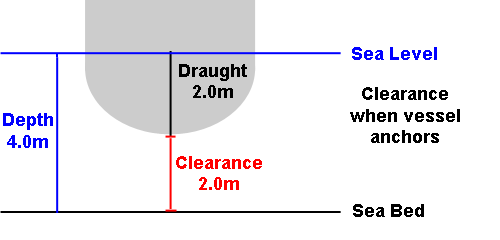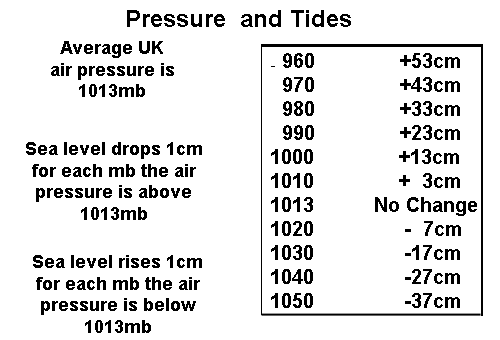Navigation and Chart work - Tidal heights when anchoring
Anchoring in tidal waters
When you anchor, you encounter a slightly different problem. You need to ensure that you will stay afloat after the tide has fallen. In some area the tidal range may be small enough that you can easily guess the correct depth to anchor in, In Britanny and the Channel Islands the tidal range can be 10m, so calculating the correct depth may be critical, too shallow and you may land on the bottom, too deep and you may not have enough anchor chain.
The whole key to this type of problem is to find the fall of the tide. That is the amount the tide will fall between the time that you anchor and low water. If you subtract this from the clearance you have under the keel when you arrive, the result will be the clearance at low water.
Follow this example:
A boat with a draught of 2.0m anchors. The Echo sounder shows the depth is 4.0m (from the surface to the sea bed), and the current height of the tide is 2.6m. If low water will be 0.8m. What will be the clearance under the keel at low water?

Current height of the tide 2.6m
- Low water 0.8m
= Fall of tide 1.8m
Current depth 4.0m
- Draught 2.0m
= Current clearance 2.0m
- Fall of tide 1.8m
= Clearance at low water 0.2m
In the rivers of the Thames Estuary where the sea bed is normally very soft mud this may be enough clearance, it the bottom is made up of sand or rock you would be wise to leave at least 1.0m clearance to allow for the unexpected.
Virtual every weekend in the Solent when it is spring tides (high water around midday) I see vessels that have failed to make this calculation when they stop for lunch then hit the bottom when the tide falls.
In the following question each answer leads to the next answer.
Question 1.
A motor yacht anchors in Victoria Harbour at 1423 Summer Time on 11 th August. The depth is 5.0m and the draught is 1.0m.
A) What is the clearance under the keel at 1423 Summer Time?
B) What is the height of tide at 1423 Summer Time?
C) How much will the tide fall between 1423 and LW?
D) What will be the clearance under the keel at LW?
After you have done this, if you found that the water was too shallow and you have already anchored, it would be necessary to raise the anchor and move-not a good way to impress your crew!
Question 2.
On 13 th August, if a boat which draws 1.3m anchors at Port Fraser at the time of HW(1553 Summer Time). What will be the clearance under the keel at LW if the depth when she anchors is 5.5m?
A much better approach is to calculate the minimum depth in which to anchor now, to ensure that after the tide has fallen there will be sufficient depth left.
To do this, decide on the minimum depth at low water (draught plus the clearance), then add the fall of tide between now and low water. If you have this calculated before you arrive in the anchorage, you can motor around looking at the echosounder until you find a spot that is at the required depth or deeper.
This has been called the FUD rule, standing for Fall, Under and Draught.
The these figure are added together they give the minimum depth in which to anchor.
Question 3.
A yacht anchors in Namley Harbour at 1310 Summer Time on 3rd November.
A) What is the height of the tide when she anchors?
B) How much will the tide fall between 1310 and LW?
C) If the boat draws 1.6m. What is the minimum depth in which to anchor at 1310, if the skipper requires a clearance of 1.0m under the keel at LW?
Effect of air pressure on sea level
It is important to remember when we make very accurate calculation for the heights of the tide that the sea level may be affected considerably by the weather. Large variations in air pressure will raise or lower the sea level, in addition to this if there are big variations in air pressure the consequent winds may change the sea level considerably or delay the time of high or low water.

Some commercial harbour broadcast the sea levels at various places at regular intervals, if tide height is critical it is worth listening in to the VTS (Vessel Traffic Service) broadcasts.
One one occasion, I dried a yacht out against a wall on the River Medway, so we could scrub off the bottom, we grounded some time after high water and the next high water was slightly higher. When high water came though, the yacht was still about 40cm off floating. Fortunately a ship went past in the channel and the wash raised the level enough for us to quickly leave the berth. This may have been caused by a large change in air pressure.
Additional Resources:

